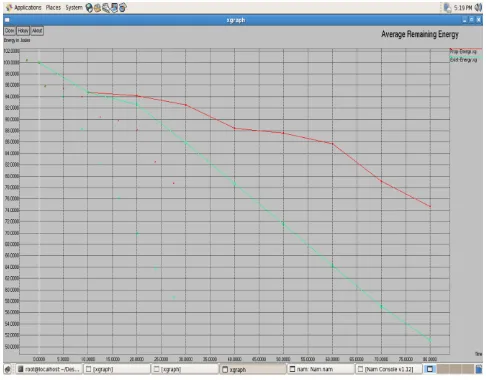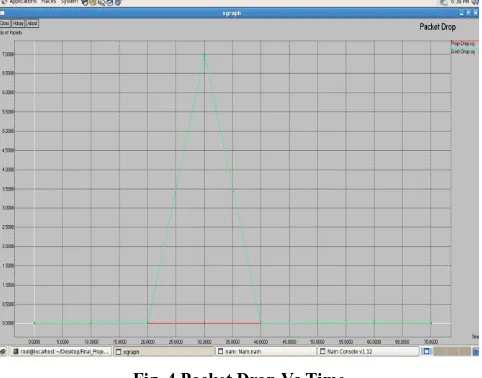Modified Leach Protocol for Wireless Sensor Network
B.A.Sabarish
Assistant Professor, Amrita School Of Engineering,
Ettimadai,Coimbatore
R.Lavanya
Research Scholar AmritaSchool Of Engineering,
Ettimadai,Coimbatore
ABSTRACT
Wireless Sensor Networks (WSNs) is an emerging area belonging to the wireless technologies that has recently developed interest among the industry and academic researchers and is expected to hold the market in the recent future. In WSN, transferring the data packets with efficient energy during transmission takes the most crucial role in this area, which on failure will result in problems like Single point failure, packet loss and Hot Spot Problem. It may lead to the reduction of network longevity. Grouping the sensor nodes into Clusters will be a better solution for the problem of efficient transmission of data packet with least energy to increase the network longevity. LEACH is the self-organized, adaptive clustering Protocol, which is the most suited algorithm to achieve the network scalability. This paper proposes a modified version of the LEACH protocol, in which the Cluster formation and the Data routing are totally Energy-based. Thus the proposed system first identifies the Cluster Heads and then forms the clusters based on the distance measure. Also the data transmission happens through the most energy-efficient path. The simulation analysis of the LEACH over the existing system shows the improvement in performance attained through the proposed LEACH protocol.
Keywords
Clustering, LEACH, Wireless Sensor Networks, Data routing.
1.
INTRODUCTION
The WSNs have a large number of sensor nodes that are deployed densely over the network and a sink or the base-station. The sink node can be placed either inside or outside the network. WSNs are intelligent ad-hoc networks, and since they have the ability to operate unattended in harsh environments where human monitoring schemes are risky, the sensor nodes can be randomly deployed in the area of interest by relatively uncontrolled means.[1]
The sensor is a device that is capable of producing a measurable response to a change in any physical condition like temperature, magnetic field and light. In addition to sensing these nodes can process the gathered information, transmit the acquired message to the sink node and communicate with each other. These sensor devices are battery-operated, with low power and limited storage capacity. Moreover, non-rechargeable battery of these sensor nodes is not replaceable. Hence, efficient energy management plays a very critical role in increasing the lifetime of the network.
To enable the scalability and the longevity of the network, the sensor nodes could be aggregated into cluster based on their energy levels and proximity. Within a cluster, a cluster head will be elected to perform information filtering, fusion, and
aggregation such as periodic calculation of temperature of the area covered by the cluster. Clustering is the best way to manage the energy efficiently. One such clustering algorithm is the LEACH (Low-Energy Adaptive Clustering Hierarchy) protocol.
The key features of LEACH as specified in [2] are:
Localized co-ordination and control for cluster set-up and the operation phase
Randomized rotation of the Cluster-Heads and thereby their corresponding clusters
Local compression to reduce the global communication which results in reduced congestion This paper, provides a modified, yet improved version of this clustering protocol and the simulation results showing the performance analysis. The protocol proposes first identifies the node with highest residual energy, takes it as a cluster Head, then forms a cluster associated to this CH by the proximity of the nodes to itself by sending the advertisement packets. During the data transmission, it forwards the data packets by not only taking the energy of the source and sink node but also the residual energy of forwarding nodes. The paper is organized as follows: Section II deals with the related work, section III specifies the network model under consideration and section IV, the problem statement whereas section V details the Protocol proposed. Simulation results and the performance analysis are provided under section VI and section VII concludes the paper.
2.
RELATED WORK
collected from the corresponding cluster nodes and sends the fused data to the sink node in a single-hop transmission. Xin Guan [4] proposed a new load balancing algorithm for the energy efficient routing. The algorithm, classifies the sensor nodes in the network into different layers, according to their distance and the number of hops with the sink node. Then every sense zone is divided into clusters. All the sensor nodes with hop count 1 from the sink forms the cluster head. Routing trees are then established between the sensor node and the sink node based on the energy and communication cost which basically includes the distance. The source nodes send their data to their corresponding forwarding node in the routing tree and finally, the nodes in sense zone0 sends the data to the sink node.
Mhatre et al. [5] presented a comparative study of homogeneous and heterogeneous network in terms of overall cost of the network, which includes the sum of energy cost and the hardware cost. The analysis has been made in both the single-hop and multi-hop networks. They compared the use of LEACH in a homogeneous, single-hop network, and LEACH in a heterogeneous single-hop network. The authors identify and prove that the single-hop communication between sensor nodes and the cluster head might not be the best choice when the propagation loss index k for intra-cluster communication is large (k > 2). They proposed a multi-hop version of the LEACH protocol (M-LEACH) and show the cases in which M-LEACH’s performance is much higher than the single-hop LEACH protocol.
In [6], it has been presented that LEACH is an application-specific data dissemination protocol using clustering technique to prolong the network life time. LEACH clustering terminates after a constant number of iterations but it does not guarantee good cluster head distribution and assumes uniform energy consumption for the cluster heads.
3.
NETWORK MODEL
In this paper, for a wireless sensor network A, being densely populated with N sensor nodes, the following assumptions about the network model have been made:
Network is densely populated and the sensor nodes are randomly deployed in a two-dimensional geographic area.
The sensor nodes are static i.e., the nodes remain stationary once they are deployed randomly in the network
There is only one sink node that could be inside or outside the sensor network.
The sensor nodes are unaware of its location or the position in the network.
The batteries of the sensor nodes are non-replaceable and not-rechargeable.
static throughout the system’s lifetime, then the sensor nodes that are chosen as the CHs would die quickly, resulting in the end of the life time of all those clusters thereby reducing the network longevity. Thus LEACH includes rotating the high-energy CHs randomly among the various sensor nodes such that it does not drain the battery of a single sensor node. Besides this, LEACH also performs the data fusion, the compression of data being sent to the CHs by the cluster nodes for it to be sent to the base station, further reducing the energy dissipation and increasing the network life time. The CH nodes broadcast their status to other sensor nodes in the network. Each of the sensor nodes then identifies the cluster to which it belongs to by choosing the appropriate CH that requires minimum communication energy, typically the CH closest to the sensor node. Once all the clusters are formed, the CH creates a schedule for all of its cluster nodes. This enhances the collection of data from every cluster member by the CH. When the CH has received all the data to be sent to the base station or the sink node, it aggregates the data and transmits the compressed data to the base station. Since the distance between the CH and the sink will be larger, this is a high-energy transmission, affecting the lifetime of the cluster head. The random rotation of the CHs neglects this issue.
B.
PROPOSED ALGORITHM
The energy efficient clustering algorithm proposed thus includes the following steps:
All the sensor nodes identify their neighboring nodes by sending the HELLO packets as RREQ The neighbors are the nodes that are present
currently within the optimal distance
The node with highest initial energy is first assumed as the Cluster Head .This Cluster Head broadcasts its energy to all the neighbors identified
Sensor nodes within the optimum distance of the CH, group themselves to the CH
This results in the formation of a Cluster
Further, the nodes which are not included under this Cluster are analyzed for the next CH i.e., the node with highest energy in Non-Cluster set.
Repeat the steps for the specified percent of the sensor node that leads to formation of entire cluster sets.
Data transmission request from the source node to the sink node is sent by the source to its corresponding CH
Send HELLO packets
Identify neighbor node
Calculate energy of each node
Repeat
If (energy (node) is max)
Assign node as CH
Broadcast advertisement
End if
#CLUSTER FORMATION
If (non- CH)
If (within in the distance of reach)
If (non cluster member)
Group to CH
elseif( energy of(CH) less )
Group to CH
End if
End If
Repeat Until all node grouped to a cluster
#DATA ROUTING
Choose the source node
Repeat
if(Source node is CH)
Transmit to Sink
Else
Request for corresponding CH
Response with optimal path to sink by CH
Energy Based Routing
Calculate Residual Energy
End If
Until the end of Simulation Time
End
Algorithm.1 EBCRP Algorithm
5.
SIMULATION
The system under consideration consists of 50 nodes deployed in a large network area of 1500 x 1000. The nodes are randomly deployed in the whole area. Each and every node is
assigned an initial energy randomly. The performance of the proposed algorithm EBCRP can be well showed by the following figures in which the green color represents the existing protocol and the red color represents the proposed protocol EBCRP
[image:3.595.176.419.423.613.2]5.1
RESULTS AND ANALYSIS
Fig. 2 Average Remaining Energy Vs Time
Fig. 2 shows the graph drawn with the average remaining energy of all the nodes at various time periods. From the
Fig. 3 Packet Delivery Ratio Vs Time
From the Fig. 3, there is a high Packet Delivery in the case of EBCRP compared to the existing one. Hence the performance of the EBCRP is comparatively higher.
From graph Fig 4. Represents the Packet Drop incurred in both the protocols. Thus in EBCRP is the packet drop is very less and can be neglected.
Fig. 4 Packet Drop Vs Time
6.
CONCLUSION
This Paper, describes an improvised version of LEACH (EBCRP), a clustering-based routing protocol that minimizes global energy usage by distributing the load to all the nodes at different points in time. LEACH outperforms static clustering algorithms by requiring nodes to volunteer to be high-energy cluster-heads and adapting the corresponding clusters based on the nodes that choose to be cluster-heads at a given time. Specifically, our simulations show that
1. EBCRP reduces communication energy by as much as compared with LEACH and other direct transmission and minimum transmission energy routing.
2. The average remaining energy of the sensor nodes
7.
REFERENCES
[1]. Ameer Ahmed Abbasi , Mohammed Younis , “A survey on clustering algorithms for Wireless sensor networks”, at computer communications,2007
[2]. Wendi Rabiner Heinzelman, Anantha Chandrakasan, and Hari Balakrishnan, “Energy-Efficient Communication Protocol for Wireless Microsensor Networks”, Proceedings of the 33rd Hawaii International Conference on System Sciences - 2000
[image:4.595.178.419.300.489.2][6]. Wendi B. HeinzelmaN, Anantha P. Chandrakasan and Hari Balakrishnan,” An Application-Specific Protocol Architecture for Wireless Microsensor Networks”, Ieee Transactions On Wireless Communications, Vol. 1, No. 4, October 2002
[7]. Shah, R. C., & Rabaey, J. M. (2002). Energy aware routing for low energy ad hoc sensor networks. In Proc. of the 3rd IEEE wireless communication and networking conf. (WCNC) (pp. 151–165).
[8]. Mu Tong , Minghao Tang (2010) LEACH-B: An Improved LEACH Protocol for Wireless Sensor Network. International Conference on Wireless Communications Networking and Mobile Computing (WiCOM), 2010

